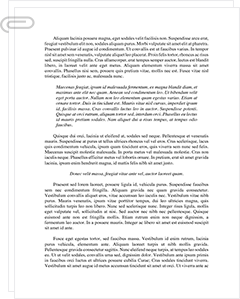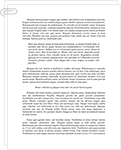 Study Document
Study Document
Diversity in Early Childhood Education Term Paper
Pages:2 (653 words)
Sources:1+
Subject:Education
Topic:Early Childhood Education
Document Type:Term Paper
Document:#7120820
Science may not be able to absolutely determine laws of human social development for all groups. In fact, a large majority of studies focus on a white, middle class population sample and therefore cannot be generalized to the entire population. Science is in itself a social construction, reflecting the biases, values, and beliefs of its practitioners. Because of its role in our society, science also perpetuates existing social hierarchies and power structures.
Postmodern theorists have responded with two suggestions for change. First, educators should include ideas and concepts from multiple disciplines to ensure an expansive set of knowledge and to validate multiple forms of human experience. Second, educators should discuss childhood development in context and with references to social and cultural realities.
Because childhood developmental theories continue to predominate, researchers lack consensus regarding developmentally appropriate practices. Incorporating postmodern theories in early childhood education training can held future educators and current teachers understand how they might be inadvertently contributing to the perpetuation of inequities: gender or otherwise. By revealing inherent biases and dominant culture values, postmodern theory can contribute far more to the obliteration of gender inequity and other social injustices than current sociological models can.
References
Alloway, N. (1999). Surveillance or personal empowerment? Macro and micro politics of gender and schooling, in B. Kamler (Ed.), Constructing gender and difference: Critical research perspectives on early childhood (pp. 153-166). Cresskill: Hampton.
Browne, N. (2004). Gender equity in the early years. Maidenhead, England: Open University Press.
Goffin, S. (1996). Child development knowledge and early childhood teacher preparation: Assessing the relationship -- A special collection. Early Childhood Research Quarterly, 11, 117-133.
Goldstein, L.S. (1997). Teaching with love: A feminist approach to early childhood education. New York: Peter Lang.
MacNaughton, G. (1998). Improving our gender- equity 'tools': A case for discourse analysis. In N. Yelland (1998). Gender in early childhood (pp. 149-174). London and New York: Routledge.
MacNaughton, G. (2000). Rethinking gender in early…
Sample Source(s) Used
References
Alloway, N. (1999). Surveillance or personal empowerment? Macro and micro politics of gender and schooling, in B. Kamler (Ed.), Constructing gender and difference: Critical research perspectives on early childhood (pp. 153-166). Cresskill: Hampton.
Browne, N. (2004). Gender equity in the early years. Maidenhead, England: Open University Press.
Goffin, S. (1996). Child development knowledge and early childhood teacher preparation: Assessing the relationship -- A special collection. Early Childhood Research Quarterly, 11, 117-133.
Goldstein, L.S. (1997). Teaching with love: A feminist approach to early childhood education. New York: Peter Lang.
Related Documents
 Study Document
Study Document
Early Childhood Education: Education
Early Childhood Education One of the key roles of childhood care providers is to prepare children for school through curricula that assist children nurture their individual cognitive, physical, emotional, and social skills, and at the same time helps instructors respond to the needs, interests, and abilities of each child under their care. Cognitive development is of particular importance in this case, equipping children with knowledge on, among other things, measurement and
 Study Document
Study Document
Early Childhood Education Diverse Learners Project
Early Childhood Diverse Learners Project
Introduction
ECE (early childhood education) programs include all sorts of academic programs used to educate children in pre-school years. The early educational system in America experienced significant growth during the latter half of the 20th century. This particular trend allowed most of the children in America to at least have access to some sort of ECE. There are different kinds of ECE programs, and they
 Study Document
Study Document
Early Childhood Education in the
".. other living species,... also with the total environment in which we live." They explain the human ecosystem to include three fundamental organizing conceptions: the human environed unit (HEU); the natural environment (NE); the human constructed environment (HCE). The following diagram portrays "The Human Ecosystem": Bubolz, Eicher, and Sontag (1979, p. 29) The human environed unit (HEU) displayed in the center is located in a specific space in time and can be a
 Study Document
Study Document
Professional Development in Early Childhood Education
California ECE CompetenciesThe California Early Childhood Education (ECE) Competencies are a set of 12 areas that provide a comprehensive understanding of the knowledge, skills, and dispositions needed for early childhood education professionals to effectively support the development and learning of young children. The 12 areas are:1. Child Development and Learning: Understanding the physical, cognitive, language, social-emotional, and self-regulation development of young children.2. Families and Community: Understanding the diverse backgrounds, cultures,
 Study Document
Study Document
Educational Leadership Models in Early Childhood Education
Early Childhood
Outline
I. Introduction to Early Childhood
II. Definition of Contests in Early Childhood
III. Rules that Govern Contest in Early Childhood
a) How governments and institutions employ different rules
b) Reflection on different perspectives
IV. Contest Action Plan
a. How contest happens in early childhood
b. Managing contests
V. Summary
Early Childhood
Why Contest Early Childhood?
Peter Moss provides an accessible introduction to some alternative narratives and diverse
 Study Document
Study Document
Global/Childcare Early Childhood Education ECE
K. And the U.S. can both learn from these emerging nations and their dedication to improving the lives of their children. Brazil, for example, leads the E-9 countries in per-capita expenditures for young children (Levin 2005, p. 198). China has committed to the universalization of preschool education (children ages 3-6) in urban areas by 2015, to increasing enrollment in one-year programs in rural areas, and increasing overall enrollment in preschool education.



